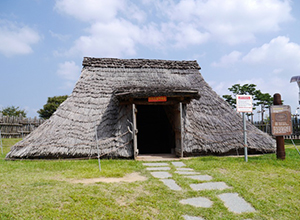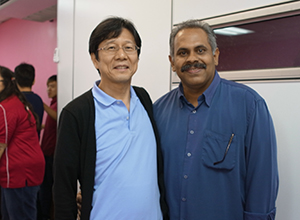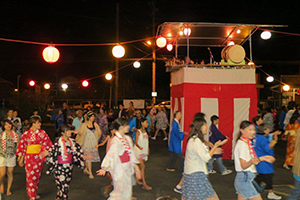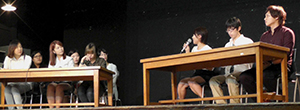Top>HAKUMON Chuo [2014 winter Issue]>From the Chuo University Faculty of Letters to abroad! Introducing the Global Studies Course
 Index
Index
Cultivating Global Professionals
From the Chuo University Faculty of Letters to abroad!
Introducing the Global Studies Course
The Global Studies Course was newly established in the 2014 academic year.
This course is intended to cultivate professionals capable of performing on a global scale and to improve students’ communication skills, including foreign language proficiency.
The following programs were held in the 2014 academic year (first term), the first year of the course.
Professor Jun Iio

Japanese and Vietnamese students after completing joint work
■Location: Ho Chi Minh City, Vietnam
■Period: August 5, 2014 to August 9, 2014
■Objective:
Use Vietnam as a case for surveying the growth process of IT industry in a developing nation. The final objective is to form an understanding for the ideal future form based on recognition of local conditions and consideration for relations with Japan
■Introduction:
During this Global Studies program targeted at Vietnam, students surveyed the growth process of the IT industry in developing nations. Through cooperation from NEC Vietnam Co., Ltd., students participating in this overseas training engaged in subjective study for a specific project case based on conditions of IT utilization in Vietnam.
In addition to onsite training conducted by NEC, a two-day workshop was held together with local Vietnamese students. Under the theme of “proposing plans for new projects to be implemented by NEC Vietnam,” practical group exercises were conducted by groups of Japanese and Vietnamese students. Following prepared presentations of advanced IT utilization examples in various countries, students were divided into three groups to discuss proposals for planning. On the second day, students gave presentations in front of a large audience, including employees of NEC Vietnam. Students then received feedback on their proposals.
In addition to learning about IT utilization in Japan and Vietnam, students were able to experience cultural differences between Japan and Vietnam. Another point worth noting is how personal networks among students were formed through practical communication in the English language. Some Chuo students still keep in contact with Vietnamese students via the Internet. Overall, the experience has equipped students to achieve great things in the future.
Professor Kenichi Kobayashi

Reconstructed residences of the Daepyeong-ri site, part of the outdoor exhibition of the Bronze Age Culture Museum, Jinju City
■Location: Busan, Changwon, Jinju, South Gyeongsang Province, Republic of Korea
■Period: September 9, 2014 to September 12, 2014
■Objective:
Onsite surveying of Korean archaeology and museums.
In this program, students visit Korea to conduct a survey of archaeological digs at sites from the prehistoric age in Korea. During the survey, we conduct a historical comparison of Japan and Korea from the Neolithic Age to the Metal Age. We also conduct comparative review for social conditions surrounding buried cultural property and archaeological research, as well as for the form of return to citizens through museum activities. Students deepen their knowledge and experience with archaeology, history and museum education, and then learn how to conduct onsite surveying.
■Introduction:
When researching Japanese history, a global perspective can be gained by conducting thorough review of external relations and exchange. In particular, the nation of Japan did not exist during the prehistoric age, so it is only natural that interaction with the Asian continent existed. It is a known fact that there was heavy traffic between Japan and the Korean Peninsula during the Neolithic age, Bronze Age, and ancient times. Student departed on a survey trip in order to engage in onsite study of such interaction. Moreover, in addition to historical research, students were able to conduct surveys according to areas of interest such as the form of museums in Japan and Korea, and the handling and social recognition for cultural assets.
We departed from Narita International Airport and landed in Gimhae International Airport. We started our trip by touring and attended a lecture at a cultural research facility in Changwon and Gimhae National Museum which is famous for its burial mounds. We then visited an excavation site in the city suburbs in order to tour dolmens from the Bronze Age. We also toured a historical park which features preservation of the Dongsam-dong shell mound. During the tours, we received explanations from leading archaeological researchers. Students experienced how many people work passionately to research prehistoric times and preserve historical ruins. We learned how both Japan and Korea place high value on clarifying history and caring for cultural assets. Our next survey trip will focus on the Seoul area, including the National Museum of Korea.
Professor Muneyoshi Hyodo

Professor Hyodo and Professor Kumaraguru, instructor of Japanese language at Universiti Teknologi Malaysia
■Location: Malaysia
■Period: March 13, 2014 to March 20, 2014
■Objective:
Conduct fieldwork using English in the multicultural society of Malaysia, thus developing the basic skills needed to perform in global society.
■Introduction:
Our recent Malaysia training excursion was the 17th time we have visited the country. However, it was the first time that we visited Universiti Teknologi Malaysia, an affiliated school of Chuo University. We started by attending a lecture given by Professor Kumaraguru, a Japanese-language instructor at Universiti Teknologi Malaysia. Professor Kumaraguru discussed the multicultural society in Malaysia. Next, a two-hour discussion performed in English and Japanese was held by Chuo students and undergraduate/graduate students studying Japanese at Universiti Teknologi Malaysia. I had heard that Japanese students on past trips had been reluctant to use English when exchanging opinions with local students, and I was worried how Chuo students would respond. However, to my surprise, most of the Malaysian students were unable to converse in Japanese and Chuo students responded by engaging in active discussion held almost entirely in English. Malaysian students displayed an interest in Japanese culture, and Chuo students gave explanations with great enthusiasm. Thanks to the good graces of Professor Kumaraguru, we were treated to a lunch of Malaysian dishes together with local students. Lively discussion was held throughout the meal. A bus arrived to transport us to our next destination, and students said their reluctant goodbyes at Universiti Teknologi Malaysia, promising to meet again. After touring Malacca, a World Heritage Site, we went to Taman Negara National Park by way of Kuala Lumpur. At the park, we visited the jungle village of the Orang Asli tribe to conduct a survey and interact with indigenous people.
Professor Takeo Morimo

Participating in Bon Dancing in the Pahoa district
■Location: Hilo and surrounding area (Hawaii Island), Hawaii, USA
■Period: August 21, 2014 to August 27, 2014
■Objective:
Through fieldwork in Hawaii, deepen understanding for the historical experiences and current lifestyles of Japanese immigrants and Japanese descendants. Also create global educational material which can be utilized at schools in order to study this topic.
■Introduction:
Through the cooperation of Professor Masafumi Honda (University of Hawaii at Hilo), we toured historical sites and facilities related to Japanese immigrants and Japanese-Americans. The base for our tours was the Hawaii Japanese Center located in Hilo. Furthermore, in addition to touring and surveying, this Global Studies program placed emphasis on actual experience. Students appeared in a program broadcast on a radio station for Japanese-Americans, participated in Japanese prayer held at Honpa Hongwanji Hilo Betsuin, participated in a memorial service at the graves of Japanese-Americans, having a Bon Festival dance in the Pahoa district, and introduced Japanese culture during a Japanese-language class at Hilo High School. At the memorial service students had the opportunity for friendly interaction with Toyoei Shigeeda, the Consul General of Japan in Hawaii and a Chuo University (Faculty of Law) graduate who attended the event as a distinguished guest.
Through these experiences, students participating in the program were able to deepen their understanding for the historical experience and current lifestyles of Japanese immigrants and second-generation Japanese living overseas. Students had almost no exposure to this topic during lessons in elementary school, junior high school and high school. Participating student were able to expand their interpersonal relationships through encounters with local residents, as well as through interaction with students from other undergraduate schools and majors. Based on the experiences described above, students created educational materials for use at schools. A wide range of outstanding educational material was created, including photography albums, picture books and manga.
Professor Yoshiro Yano

Scene from debate at Hankuk University of Foreign Studies
■Location: Hankuk University of Foreign Studies, Sookmyung Women's University, Seoul, Republic of Korea
■Period: September 15, 2014 to September 18, 2014
■Objective:
Live debate with Korean students.
■Introduction:
In response to requests from seminar students to hold a seminar workshop in Korea, eighteen students majoring in sociology in the Yano Seminar traveled to Seoul from September 15 to 18. My seminar is unrelated to Korea, and I personally had never been to Korea. The trip was made possible by the effort of seminar students, particularly Oh Gayun and Ha Hyeon, who took the initiative to fulfill various roles including coordination with Korean universities, interpretation and serving as a tour guide.
Based on the six themes of economics, family, education, culture, religion and politics, seminar students were divided into six groups and prepared issues for comparative debate of Japanese and Korean society. We visited two universities in Korea. First, we held a public debate with about fifty Korean students who study Japanese language under the instruction of Dean at Don-Gyu Kim at College of Japanese in the Hankuk University of Foreign Studies. The next day, we held a roundtable discussion with several dozen students from the Sookmyung Women's University. As expected of young people, they didn’t hesitate to ask each other frank questions. “What do you think of the conscription system?” “Do you support the president?” “Do you have a boyfriend?” The open atmosphere produced great results. Students engaged in lively discussion on both days of our trip. Even after the scheduled time had ended, students continued to talk for a long time while eating lunch and relaxing on nearby benches.
Students engaged in lively communication, something which is not possible through books or the internet. Our trip to Korea taught us that this is the real value of the Global Studies program.
Professor Shigenori Wakabayashi

Interaction between Chuo students and faculty/students from the University of Hawaii at Manoa
■Location: Honolulu (University of Hawaii at Manoa, and others), Hawaii, USA
■Period: September 15, 2014 to September 20, 2014
■Objective:
Research presentation related to Japanese-English language comparative research and second-language acquisition research at the University of Hawaii at Manoa. Study of Hawaii-Japan relations, training related to Hawaiian history and geography.
■Introduction:
This program in Hawaii consisted of fulfilling training with an extremely wide variety of activities. First, during a research presentation at the Chuo-UHM Conference, Chuo students engaged in lively debate with prominent researchers and students at the University of Hawaii. In addition to students who actually gave presentations, this was also a meaningful experience for students who viewed the presentations. Through this debate, our students recognized the high level of research continued at Chuo University and reaffirmed the difficult associated with conducting research. Students also learned about the natural environment while enjoying snorkeling at Hanauma Bay. The trip also featured historical studies via tours of the USS Arizona Memorial and Battleship Missouri Memorial which are located in Pearl Harbor. This gave students a first-hand experience of conditions during World War II and changed their impression of Hawaii. Without doubt, the program was a great success in expanding the horizons of students.
- Research Activities as a Member of Research Fellowship for Young Scientists (DC1), Japan Society for the Promotion of Science (JSPS) Shuma Tsurumi
- Important Factors for Innovation in Payment Services Nobuhiko Sugiura
- Beyond the Concepts of Fellow Citizens and Foreigners— To Achieve SDGs Goal 10 “Reduce Inequality Within and Among Countries” Rika Lee
- Diary of Struggles in Cambodia Fumie Fukuoka
- How Can We Measure Learning Ability?
—Analysis of a Competency Self-Assessment Questionnaire— Yu Saito / Yoko Neha - The Making of the Movie Kirakira Megane








